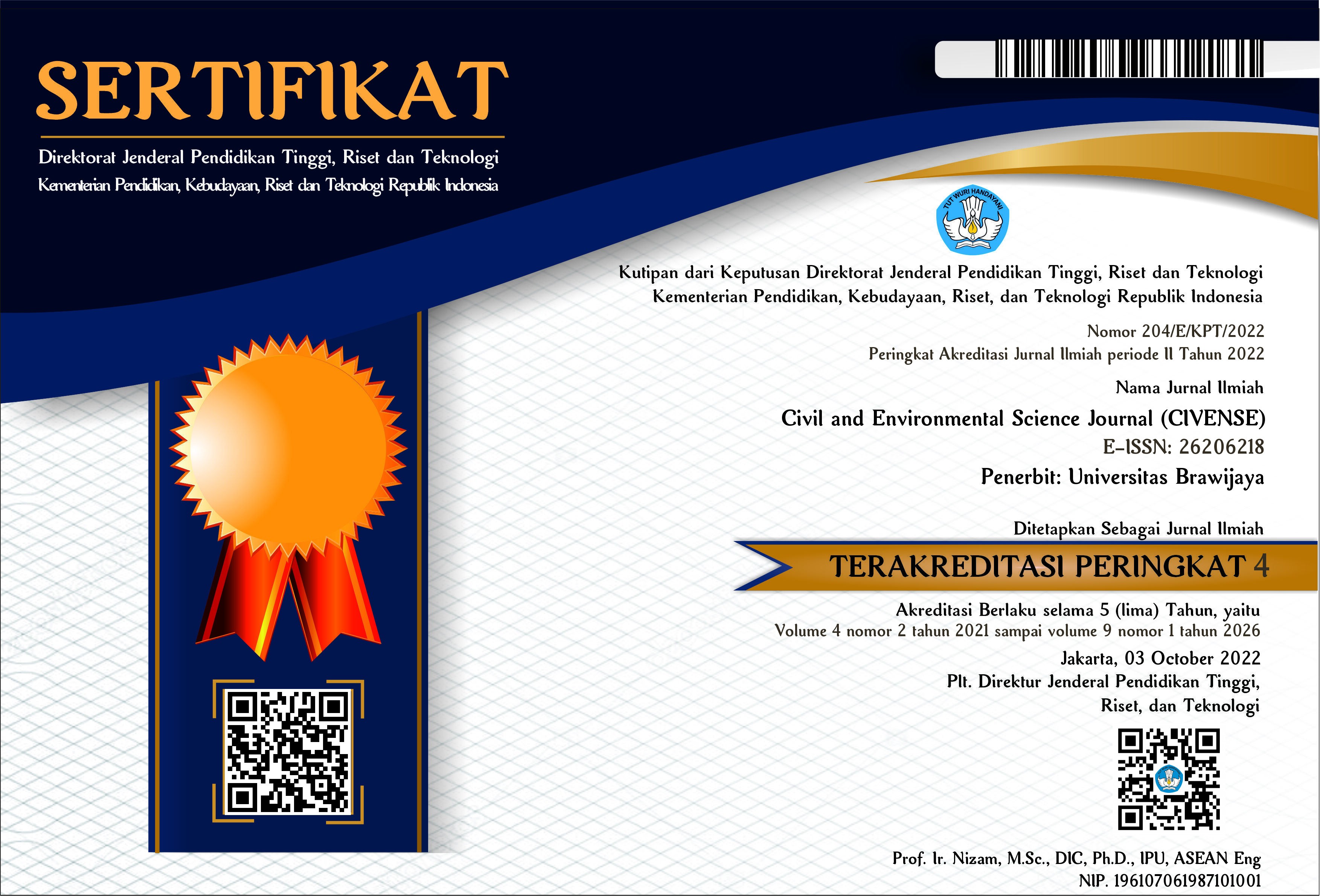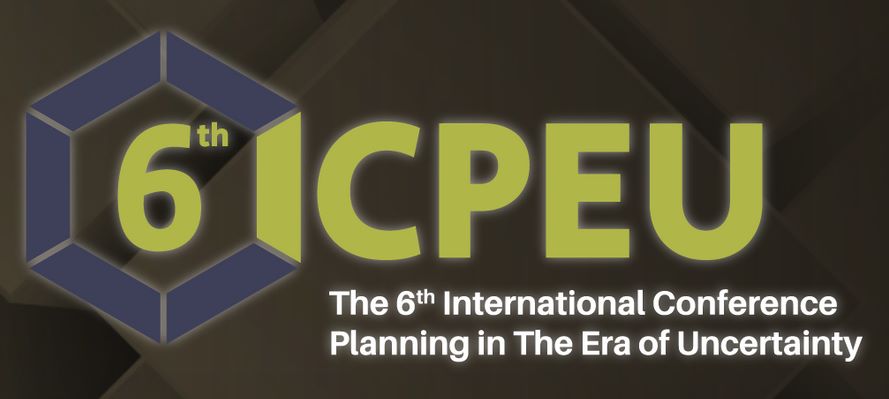Using Water Balance to Analyse Water Availability for Irrigation with Upraising Surface Temperature ( Acase Study Pasar Baru Barrage in Cisadane Watershed)
DOI:
https://doi.org/10.21776/ub.civense.2020.00301.1Keywords:
water balance, Ciliwung-Cisadane watershed, water requirement, irrigation, water availabilityAbstract
This research aims to determine the water balance between water demand and availability at Pasar Baru Barrage. Pasar Baru Barage supply irrigation water for 22.441 ha. Irrigation water requirements related to temperature, evapotranspiration, and precipitation. Higher air temperature in a region, influents the water requirement. This research was also conducted to see the effect of the rise in temperature of the water needs. The water requirement is calculated based on the needs of irrigation and domestic water to the raw water. For irrigation water needs calculated by planning a cropping pattern in one year in this study, it was planned to plant rice twice and once crop, evapotranspiration was calculated using the Penmann Modification method, so that water requirement in the intake area was obtained multiplying the area of irrigation. Calculation of water availability by using FJ Mock method, the maximum water availability value is 11.75 m3 / second. so that the water balance is obtained by the surplus deficit water balance method. After conducting this study, it can be seen that the air temperature in the cisadane weir of the new market is increasing from 1985 to 2018. The average temperature increases by 0.740C, the minimum air temperature increases by 0.80C and the maximum increases by 0.20C, the average evapotranspiration value decreases by 0.15 mm / day, while the average water availability decreases from the year 1985 to 2018 at 1.8 m3 / second, the amount of water needed for irrigation was 5.57 liters/ second/ha.  The calculation of the water balance in the river is based on a reliable discharge, the result is a deficit every year from 1985 to 2018. So there is a need for Pasar Baru weir to overcome the lack of irrigation water every year, based on discharge data available at Pasar Baru weir from 2013 to 2015, it can seen that the water balance has a surplus every year, the water balance deficit only occurred in July 2015 of 0.3 m3 / sec. The largest water balance occurred in March 2014 amounting to 656.97 m3 / sec. The results of this study can be used as a reference in planning and developing integrated water resources buildings especially in the Cisadane watershed and the Ciliwung-Cisadane river basin in general.
References
Intergovernmental Panel on Climate Change, IPCC Fourth Assessment Report : Climate Change 2007
NASA, World Global Temperature, article site : https://earthobservatory.nasa.gov/WorldOfChange/DecadalTemp, access on Oct 2018.
Peterson, Thomas C., Vose, Russel S., 1997 An Overview of the Global Historical Climatology Network Temperature Database, Bulletin of the American Meteorological Society, Vol. 78, No. 12, December 1997.
Christy, J. R., W. B. Norris, and R. T. McNider (2009), Surface temperature variations in East Africa and possible causes, J. Clim., 22, 3342–3356, doi:10.1175/2008JCLI2726.1.
NOAA National Centers for Environmental Information, State of the Climate: Global Climate Report for January 2018, published online February 2018, retrieved on October 29, 2018 from https://www.ncdc.noaa.gov/sotc/global/201801.
Karl, T. R., C. N. Williams, P. J. Young, and W. M. Wendland (1986), Model to estimate the time of observation bias associated with monthly mean maximum, minimum and mean temperatures for the United States, J. Clim. Appl. Meteorol., 25, 145–160, doi:10.1175/1520-0450(1986)025<0145:AMTETT>2.0.CO;2.
Zabel F. (2016) Impact of Climate Change on Water Availability. In: Mauser W., Prasch M. (eds) Regional Assessment of Global Change Impacts. Springer, Cham Pathak, Surendra,. et all, 2014, Climate change and water availability in Indian agriculture: Impacts and adaptation, Indian Journal of Agricultural Sciences, 84(6):671-679
Karmeshu, N. (2012). Trend detection in annual temperature & precipitation using the Mann Kendall test–a case study to assess climate change on select states in the northeastern United States (Tesis). University of Pennsylvania, Pennsylvania, USA. Diperoleh dari http://repository.upenn.edu/cgi/view content. cgi?article=1045&context=mes_capstones
Ahmad, Ijaz, Deshan Tang, Tianfang Wang, Mei Wang, and Bakhtawar Wagan. 2015. “Precipitation Trends over Time Using Mann-Kendall and Spearman ’ s Rho Tests in Swat River Basin , Pakistan.†2015.
Blain, Gabriel Constantino. 2013. “Acta Scientiarum The Mann-Kendall Test : The Need to Consider the Interaction between Serial Correlation and Trend.†(iid):393–402.
Journal, International. 2014. “Trend Analysis of Hydro-Meteorological Variables Using The Mann-Kendall Trend Test : Aplication to the Niger River. 100-110.
Mondal, Arun, Sananda Kundu, and Anirban Mukhopadhyay. 2012. “Rainfall Trend Analysis by Mann-Kendall Test : A Case Study of North-Eastern Part of Cuttack District , Orissa Rainfall Trend Analysis by Mann-Kendall Test (February 2015).
Downloads
Published
How to Cite
Issue
Section
License
Copyright (c) 2020 Civil and Environmental Science Journal

This work is licensed under a Creative Commons Attribution-NonCommercial 4.0 International License.
Authors who publish with this journal agree to the following terms:
Authors retain copyright and grant the journal right of first publication with the work simultaneously licensed under a Attribution-NonCommercial 4.0 International License that allows others to share the work with an acknowledgement of the work's authorship and initial publication in this journal.
Authors are able to enter into separate, additional contractual arrangements for the non-exclusive distribution of the journal's published version of the work (e.g., post it to an institutional repository or publish it in a book), with an acknowledgement of its initial publication in this journal.
Authors are permitted and encouraged to post their work online (e.g., in institutional repositories or on their website) prior to and during the submission process, as it can lead to productive exchanges, as well as earlier and greater citation of published work (See the Effect of Open Access).














